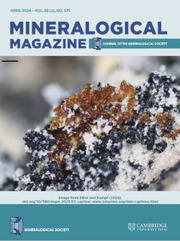Crossref Citations
This article has been cited by the following publications. This list is generated based on data provided by
Crossref.
Dove, M. T.
Hammonds, K. D.
Harris, M. J.
Heine, V.
Keen, D. A.
Pryde, A. K. A.
Trachenko, K.
and
Warren, M. C.
2000.
Amorphous silica from the Rigid Unit Mode approach.
Mineralogical Magazine,
Vol. 64,
Issue. 3,
p.
377.
Trachenko, Kostya O
Dove, Martin T
Harris, Mark J
and
Heine, Volker
2000.
Dynamics of silica glass: two-level tunnelling states and low-energy floppy modes.
Journal of Physics: Condensed Matter,
Vol. 12,
Issue. 37,
p.
8041.
Farnan, I.
and
Dove, M. T.
2000.
Structure and dynamics of silicate glasses and melts.
Mineralogical Magazine,
Vol. 64,
Issue. 3,
p.
373.
Tucker, M. G.
Keen, D. A.
and
Dove, M. T.
2001.
A detailed structural characterization of quartz on heating through the α–β phase transition.
Mineralogical Magazine,
Vol. 65,
Issue. 4,
p.
489.
Schönau, Kristin A.
and
Redfern, Simon A. T.
2002.
High-temperature phase transitions, dielectric relaxation, and ionic mobility of proustite, Ag3AsS3, and pyrargyrite, Ag3SbS3.
Journal of Applied Physics,
Vol. 92,
Issue. 12,
p.
7415.
Khaliullin, Rustam Z.
and
Bell, Alexis T.
2002.
A Density Functional Theory Study of the Oxidation of Methanol to Formaldehyde over Vanadia Supported on Silica, Titania, and Zirconia.
The Journal of Physical Chemistry B,
Vol. 106,
Issue. 32,
p.
7832.
Huang, Liping
and
Kieffer, John
2005.
Structural Origin of Negative Thermal Expansion in High-Temperature Silica Polymorphs.
Physical Review Letters,
Vol. 95,
Issue. 21,
Withers, Ray L.
and
Liu, Yun
2005.
A coupled electron diffraction and rigid unit mode (RUM) study of the crystal chemistry of some zeotypic AlPO4 compounds.
Journal of Solid State Chemistry,
Vol. 178,
Issue. 9,
p.
2647.
Bates, Simon
Zografi, George
Engers, David
Morris, Kenneth
Crowley, Kieran
and
Newman, Ann
2006.
Analysis of Amorphous and Nanocrystalline Solids from Their X-Ray Diffraction Patterns.
Pharmaceutical Research,
Vol. 23,
Issue. 10,
p.
2333.
Bates, Simon
Kelly, Ron C.
Ivanisevic, Igor
Schields, Paul
Zografi, George
and
Newman, Ann W.
2007.
Assessment of Defects and Amorphous Structure Produced in Raffinose Pentahydrate upon Dehydration.
Journal of Pharmaceutical Sciences,
Vol. 96,
Issue. 5,
p.
1418.
Olszta, Matthew J.
Cheng, Xingguo
Jee, Sang Soo
Kumar, Rajendra
Kim, Yi-Yeoun
Kaufman, Michael J.
Douglas, Elliot P.
and
Gower, Laurie B.
2007.
Bone structure and formation: A new perspective.
Materials Science and Engineering: R: Reports,
Vol. 58,
Issue. 3-5,
p.
77.
Ligny, D. de
Neuville, D.R.
Cormier, L.
Roux, J.
Henderson, G.S.
Panczer, G.
Shoval, S.
Flank, A.-M.
and
Lagarde, P.
2009.
Silica polymorphs, glass and melt: An in situ high temperature XAS study at the Si K-edge.
Journal of Non-Crystalline Solids,
Vol. 355,
Issue. 18-21,
p.
1099.
Ivanisevic, Igor
McClurg, Richard B.
and
Schields, Paul J.
2010.
Pharmaceutical Sciences Encyclopedia.
p.
1.
Shen, Guoyin
Mei, Qiang
Prakapenka, Vitali B.
Lazor, Peter
Sinogeikin, Stanislav
Meng, Yue
and
Park, Changyong
2011.
Effect of helium on structure and compression behavior of SiO
2
glass
.
Proceedings of the National Academy of Sciences,
Vol. 108,
Issue. 15,
p.
6004.
Khavryuchenko, Volodymyr D.
Khavryuchenko, Oleksiy V.
and
Lisnyak, Vladyslav V.
2011.
Formation of Pyrogenic Silica: Spectroscopic and Quantum Chemical Insight.
Critical Reviews in Solid State and Materials Sciences,
Vol. 36,
Issue. 2,
p.
47.
Yuan, Fenglin
and
Huang, Liping
2012.
α–βtransformation and disorder inβ-cristobalite silica.
Physical Review B,
Vol. 85,
Issue. 13,
Kovács Kis, Viktoria
Czigány, Zsolt
and
Németh, Tibor
2017.
Nanostructural investigation of slightly altered rhyolitic volcanic glass.
Materials Characterization,
Vol. 127,
Issue. ,
p.
121.
Nhan, Nguyen Thu
Trang, Giap Thi Thuy
Iitaka, Toshiaki
and
Hong, Nguyen Van
2019.
Crystallization of amorphous silica under compression.
Canadian Journal of Physics,
Vol. 97,
Issue. 10,
p.
1133.
Chen, YuHui
Hu, Xing
Lin, Tong
Li, Yi
and
Ling, ZhiYuan
2021.
Obtaining transparent silica glass from nano-silica hydrosol.
Ceramics International,
Vol. 47,
Issue. 14,
p.
19340.
Dung, Mai Van
2022.
Structural properties of silica under the temperature.
Journal of Physics: Conference Series,
Vol. 2312,
Issue. 1,
p.
012045.

